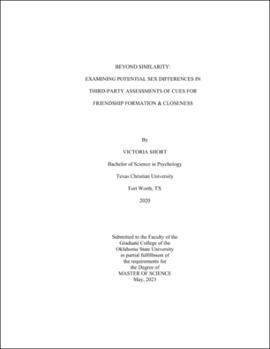| dc.contributor.advisor | Byrd-Craven, Jennifer | |
| dc.contributor.author | Short, Victoria | |
| dc.date.accessioned | 2023-08-25T20:06:29Z | |
| dc.date.available | 2023-08-25T20:06:29Z | |
| dc.date.issued | 2023-05 | |
| dc.identifier.uri | https://hdl.handle.net/11244/338959 | |
| dc.description.abstract | Friendships are affiliative bonds that we share with non-kin and can benefit our health and welfare through providing support to handle challenges in our environments. Individuals who can accurately infer which people are likely to become friends as well as closeness between existing friends are able to navigate complex social networks and make decisions about: 1) who is available to be their friend and, 2) who can provide support they could benefit from. The kind of support people can benefit from in their friendships may overlap to an extent, however, some aspects of our environmental obstacles can be more specific to our social networks and hierarchies. Men and women’s friendship preferences have shown to vary based on these relationships’ functions; however, we do not yet understand how individuals infer interest in friendship formation or closeness between same-sex others according to these preferences. Across two studies, we examined how self-disclosure, venting, similarity, and teasing behavior may provide cues to individuals about others and their friendship potential as well as closeness. Results from Study 1 revealed that before a friendship is established, both men and women used cues of similarity to infer whether two strangers should become friends in addition to their interest in becoming friends. However, Study 2 demonstrated that when making inferences about existing friends, women think two friends are closer when they vent to one another over friends who tease or share interests with one another; while men think two friends are closer when they tease each other over friends who vent or share interests with one another. Results also showed that in some situations men and women use similar cues to infer closeness between friends (i.e., both think friends are closer if they vent compared to friends who share things in common; both also infer friends are closer when they seek emotional support over friends who vent to one another). These findings suggest that similarity is important when assessing an interaction between strangers, however, with closer affiliative bonds, men and women rely on more varied cues to gather information about these relationships. | |
| dc.format | application/pdf | |
| dc.language | en_US | |
| dc.rights | Copyright is held by the author who has granted the Oklahoma State University Library the non-exclusive right to share this material in its institutional repository. Contact Digital Library Services at lib-dls@okstate.edu or 405-744-9161 for the permission policy on the use, reproduction or distribution of this material. | |
| dc.title | Beyond similarity: Examining potential sex differences in third-party assessments of cues for friendship formation & closeness | |
| dc.contributor.committeeMember | Krems, Jaimie A | |
| dc.contributor.committeeMember | Grant, DeMond | |
| osu.filename | short_okstate_0664M_18097.pdf | |
| osu.accesstype | Open Access | |
| dc.type.genre | Thesis | |
| dc.type.material | Text | |
| dc.subject.keywords | affiliation | |
| dc.subject.keywords | closeness | |
| dc.subject.keywords | friendship | |
| dc.subject.keywords | sex differences | |
| dc.subject.keywords | social networks | |
| dc.subject.keywords | third-party assessments | |
| thesis.degree.discipline | Psychology | |
| thesis.degree.grantor | Oklahoma State University | |
